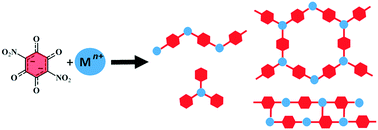Nitranilic acid as a basis for construction of coordination polymers: from discrete monomers to 3D networks†
Abstract
Six novel transition metal complexes of nitranilic acid (3,6-dinitro-2,5-dihydroxyquinone) were prepared and characterised. The nitranilate dianion was shown to be an especially versatile ligand, able to bridge metal cations and form different types of coordination polymers. Five different coordination modes were identified, two of which [as a terminal bidentate ligand and as a bridging (bis)bidentate ligand] are common for other quinones, while the other three are novel. Coordination polymers of different topologies and dimensionalities were obtained: discrete monomers (0D), zigzag chains and ladder-like double chains (1D), layers (2D) and 3D networks.



 Please wait while we load your content...
Please wait while we load your content...